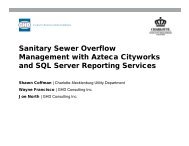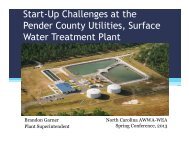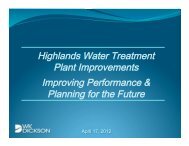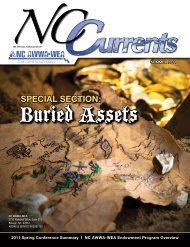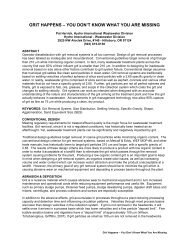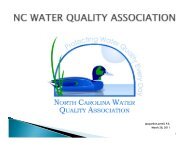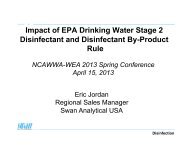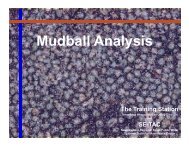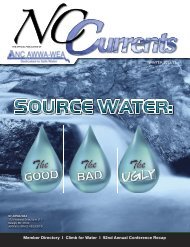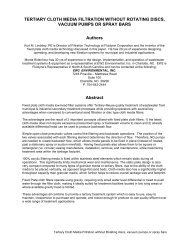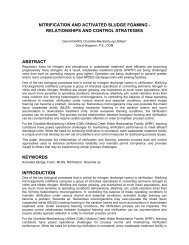HANDLING FATS, OILS & GREASES (FOG) AT WASTEWATER ...
HANDLING FATS, OILS & GREASES (FOG) AT WASTEWATER ...
HANDLING FATS, OILS & GREASES (FOG) AT WASTEWATER ...
You also want an ePaper? Increase the reach of your titles
YUMPU automatically turns print PDFs into web optimized ePapers that Google loves.
INTRODUCTIONFats, Oils, and Grease (<strong>FOG</strong>) is a generic term for a myriad of organic compounds that exhibithydrophobic characteristics, liquefy when heated and yield methane when digested anaerobicallyor have a high energy content that is released in thermal oxidation. The acceptance andprocessing of <strong>FOG</strong> wastes from truck haulers at municipal wastewater treatment plants(WWTPs) are of increasing interest because of the need to keep these materials out ofwastewater collection systems, as well as the added energy recovery potential when <strong>FOG</strong> wastesare anaerobically digested or incinerated. The addition of <strong>FOG</strong> wastes to a WWTP usuallyrequires combining <strong>FOG</strong> waste with WWTP sludges in a process that utilizes the energy from<strong>FOG</strong> such as anaerobic digestion or incineration. The manner in which this is done can impactthe performance of the anaerobic digesters or incinerator as well as other solids handlingprocesses, and so must be done properly.The principal focus of this paper is not on energy recovery but rather on alternate methods of<strong>FOG</strong> waste acceptance and pre-processing that can be used, as these methods are an emergingpractice. The state-of-the-art is not resolved, but the growing interest on energy recovery in ourindustry is pushing it forward. Thus, a thorough understanding of the types of <strong>FOG</strong> handled andits characteristics is needed to allow for a systematic approach to be developed. Therefore, thegoal of this paper is to illustrate some of the <strong>FOG</strong> waste acceptance and pre-processing practicesthat have worked, and to stimulate discussion.CHARACTERISTICS OF <strong>FOG</strong> WASTESTypical <strong>FOG</strong> characteristics from various sources are presented in Table 1.Table 1 – Characteristics of liquid and semi-solid <strong>FOG</strong> wastes 3ComponentRestaurantInterceptor<strong>FOG</strong> WasteBiodieselglycerinPolymerDewatered<strong>FOG</strong>LimeDewatered<strong>FOG</strong>Total Solids, %TS 1.8-21.9 14.7 42.4 49.1Volatile Solids/Total Solids, % 88.9-98.6 95.2 96.5 76.5Chemical oxygen demand, g/L 1,160 1,211 1,030Total nitrogen, g/L 5.4Total phosphorus, g/L 0.128 0.67pH 4.3-4.8 8.4 4.0 6.5Volatile solids destruction potential 1 , % 70.8 78.3Methane content of generated gas, % 75.0 74.6Methane (CH 4 ) potential yield 2 , m 3 /kg(scf/lb) feedstock volatile solidsBiogas potential yield 2 , m 3 /kg (scf/lb)feedstock volatile solids1.048 (16.8) 0.927 (14.8)1.398 (22.4) 1.242 (19.9)1 Maximum potential volatile solids destruction and yield based on long-term (120 days batch)2 At 60 o F and 1 atm3 From Bailey (2007); Parry et al. (2009); Kabouris et al. (2007)
Generally, <strong>FOG</strong> varies in composition from 2-20% total solids (TS) of which anywhere from 80to 99% of the TS content is volatile. When dewatered after chemical conditioning, the semisolid<strong>FOG</strong> TS can increase to upwards of 50% TS, with 75-95% volatile content.This range in <strong>FOG</strong> characteristics directly effects which <strong>FOG</strong> recovery scheme is most suitablefor a specific WWTP. Typically, a <strong>FOG</strong> recovery scheme can be integrated into a WWTP eitherwithin the existing liquid treatment or solids processing trains. Generally, <strong>FOG</strong> receivingschemes, when coupled with energy recovery, are designed to maximize the efficiency of thecombined operation. Thus, from a hauling perspective alone, dewatering and hauling as a cakewould be more cost effective. However, receipt as a liquid <strong>FOG</strong> waste is more common andrequires less processing at the WWTP.WWTPs without specific receiving <strong>FOG</strong> facilities generally accept <strong>FOG</strong> as a liquid waste intothe liquid treatment train where it is separated as primary scum, or a secondary scum that isusually returned to the primary sedimentation tank for removal as primary scum. At thesefacilities, <strong>FOG</strong> waste has been typically accepted as part of a septage receiving operation. Suchstations will usually involve rock traps and coarse screening followed by transfer to theheadworks and primary sedimentation tanks. <strong>FOG</strong> not captured as primary scum can be lost tothe secondary treatment process, cling to the walls of basins, channels, or piping, form greaseballs, etc. The results include a loss in energy-yielding material, an ongoing maintenanceactivity, and occasional overloading of the primary scum wells. Accurate estimates of <strong>FOG</strong> lost(i.e. not recovered) will require further study, but it can be assumed that at least 15% of <strong>FOG</strong>received in this manner is lost to the energy recovery systems.With the emerging interest in energy recovery, <strong>FOG</strong> wastes are being routed around the liquidtreatment train directly to the solids processing train and into anaerobic digestion or thermaloxidation systems. Separate onsite receipt for anaerobic digestion will usually involve screening,heating, grit/rock removal, equalization and transfer to anaerobic digestion either directly or afterblending with other digester feed sludges. The loss of material in transit from acceptance toprocessing is minimal with dedicated facilities. These facilities can also support the fractionationof the waste into a <strong>FOG</strong>-rich supernatant to maximize volatile solids addition in conjunction witha <strong>FOG</strong>-lean underflow that would be returned to the liquid train.<strong>FOG</strong> acceptance facilities for energy recovery via thermal oxidation are more complicated andrequire one or more concentration steps to ensure that the water content is minimized beforeblending with the feed sludge and thermal oxidation. The steps can variously include:• Scum/<strong>FOG</strong> concentration with heat addition to improve flow properties (at least 90 degreesF), the scum\<strong>FOG</strong> can be concentrated to the 50% VS range after deanting. This material islabeled as concentrated scum (CS).• With heat addition to the 150 degree F range, and the decanting of concentrated scum/<strong>FOG</strong>,decanted concentrated scum/<strong>FOG</strong> (DCS) can be concentrated to 75 to 85% <strong>FOG</strong> VS.• The CS or DCS is then either blended with or added to dewatered sludge cake before transferto a thermal oxidation unit.The <strong>FOG</strong>-amended feed to the thermal oxidation unit will substantially increase the energycontent of the feed, thereby reducing the supplemental fuel needed by multiple hearthincinerators and increasing the energy recovery potential in waste heat recovery boiler units influidized bed incinerators.
REFERENCE FACILITIESTable 2 describes four facilities which exemplify elements of most <strong>FOG</strong> handling systems.Table 2 – Reference facilities with specific elements of <strong>FOG</strong> handlingParameter EJWWTF, VT 1 Pinellas County, FL 2 HRSD, VA 3 JCW, KS 4Facility Size3.3 mgd33 mgd22.5 mgd14.5 mgd<strong>FOG</strong> QuantitiesReceived2,000 gpd averageday and 9,500 gpdpeak day.2,000 – 6,000 drylb/day of dewatered<strong>FOG</strong>, 5 days/week4,600 gpd average and6,805 gpd peak12,400 gpd average dayand 30,000 gpd peakdayOff-loadingQuick connect hoseconnectionQuick connect hoseconnectionCombined with SeptageReceivingQuick connect hoseconnectionTransfer tostorageBy gravity to primaryscum pitRotary lobe PumpCollected with primaryscum in primaryclarifiersCombination in linegrinder/rotary lobepumpStorageExisting primaryscum pit (3,000gallons)5,000 gal. dewatered<strong>FOG</strong> storage tank atSCBWRFWithin ScumConcentrator andHopperThree 15,000 gallonfiberglass reinforcedplastic or polyethylenetanks inside a buildingMixingNoneRecirculation of stored<strong>FOG</strong> using rotary lobepumpNoneRecirculate <strong>FOG</strong> wasteusing rotary lobe pumpthrough the heatexchanger and grinder;HeatingNoneTemporary heatingused during winter.Hot water heatexchangers to maintain<strong>FOG</strong> temperature toabut 130 o FHot water heatexchangers to maintain<strong>FOG</strong> temperature toabout 80ºFDigester orThermalOxidationFeedingPositivedisplacement pumpfeeds <strong>FOG</strong> & scummixture to digestersRotary lobe pump usedto pump to digestersrecirculation pipeline.Pumped to mix point ofdewatered solidsconveyor to feed MHFProgressing cavitypumps will feed <strong>FOG</strong> todigesters.Load TrackingMonitor haulersMonitoring <strong>FOG</strong>volume received at<strong>FOG</strong> dewateringfacilityMonitor haulersPanel containing keypad access; track bycompany, driver andload; security camera atunloading station.Wash downPlant water hose bibbavailable, if needed.Plant water available.Plant water availablePower sprayer available.Concrete access area;wash-down water drainsto plant drain system.Odor ControlNone. Scum pit iscovered.Cartridge filter installedon the vent line of thestorage tankNoneBiotower with carbon1 Personal communication with Jim Jutras, 20102Personal communication with Mike Engelmann, 2010.3 Shea et al, 20094Gabel et al, 2009Descriptions of the features of facilities outlined in Table 2 are provided below.
Johnson County, KSThe expansion of the Douglas L. Smith Middle Basin Wastewater Treatment Plant (MiddleBasin WWTP) in Johnson County, Kansas to 14.5 million gallons per day (mgd) averagecapacity includes an environmentally friendly approach for the treatment of <strong>FOG</strong> wastes fromlocal restaurants and industrial sources. <strong>FOG</strong> waste receipts are handled using a separate onsiteliquid receiving facility consisting of the following:• <strong>FOG</strong> waste unloading station• Rotary lobe receiving pumps with inline grinder and integrated debris/sediment trap• Storage tanks• Pumped mixing and heating• Heat exchangers• Progressing cavity digester feed pumps• Odor controlReceived <strong>FOG</strong> waste is first pumped through a debris/sediment trap then through a grinder andthe heat exchangers to be pre-heated before entering the storage tanks. The receiving pumps willalso continually mix the contents of the tank as well as maintain a temperature of about 80 o F tominimize issues with pumping the material. Separate pumps transfer the <strong>FOG</strong> waste to theanaerobic digesters. Insulated force mains with numerous several cleaning taps are provided incase one pipeline becomes clogged. Enhanced gas production from the anaerobic digesters willfuel a 2.12-MW biogas co-generation system that utilizes two duty 1060-kW generators.Industrial <strong>FOG</strong> waste producers from several food processing facilities located within the countyhave or are planning to install dewatering equipment for their thickened <strong>FOG</strong> waste stream toreduce truck hauling costs. One food processor is currently dewatering thickened <strong>FOG</strong> wasteusing polymer and a plate and frame filter press. Another is dewatering using polymer andgravity draining in super-sacks. Other processors are evaluating belt filter presses.To capture these high energy waste streams, a dewatered <strong>FOG</strong> waste receiving station is underdesign for the Middle Basin WWTP. This facility will include equipment and processes todevelop a slurry that will be pumped to the storage tanks in the liquid <strong>FOG</strong> waste receivingstation for further processing and blending with the liquid <strong>FOG</strong> waste prior to being fed to thedigesters. The facility will consist of two below-grade tanks with hoppers to receive thedewatered material from end-dump trucks or roll-offs. A high-pressure water jet will initiate theslurry formation and force the material through an in-line grinder prior to being pumped byrotary lobe pumps to the mixing tank. A pumped mix system in the mixing tank, consisting ofnon-potable water, submersible chopper pump, and heat exchanger will precondition the materialprior to being pumped to the liquid <strong>FOG</strong> waste receiving facility.Hampton Roads, V<strong>AT</strong>he Hampton Roads Sanitation District (HRSD), Williamsburg WWTP utilizes a multiple hearthincinerator (MHF) to incinerate biosolids. By blending liquefied <strong>FOG</strong> and scum into dewateredsolids, the facility can recovery energy in the form of reduced natural gas usage. <strong>FOG</strong> iscollected concurrently with septage at a receiving pit. The <strong>FOG</strong> is screened through theheadworks and is transferred between processes before ultimately being captured in the primary
sedimentation basins with the primary scum. A scum concentrator thickens the mixture where itcollected in a hopper and heated to approximately 130 o F. The <strong>FOG</strong> rich float is decanted andpumped to the midpoint of the dewatered solids conveyor for blending prior to entering theincinerator. The aqueous subnatant from the scum concentrator is recycled back to the head ofthe scum concentrator.Pinellas County, FLThe Pinellas County, FL South-Cross Bayou Water Reclamation Facility (SCBWRF) utilizesanaerobic digestion and sludge drying for solids disposal. <strong>FOG</strong> is accepted at an offsitereceiving facility where dewatering operations take place. Generally, the dewatering operationsare as follows:• The daily receipts are accumulated, mixed, and dosed at 1.5% polymer on a volumetric basis(15 gallons of polymer solution per 1,000 gallons of <strong>FOG</strong> waste).• The polymer-conditioned waste is stored overnight in a fine-screen dewatering tank, resultingin about 80% reduction in the weight of the <strong>FOG</strong> due to dewatering. The dewatered <strong>FOG</strong>concentration is typically about 20-30% solids.• The dewatered <strong>FOG</strong> is then transferred from the dewatering tank to a roll-on/roll-offcontainer for transfer to the WWTP.• The roll-on/roll-off container is equipped with a bottom drain and coupling such that whenthe container is received at the WWTP, the container is connected by hose to a rotary lobepump for transfer to a storage tank.Once at the facility, the <strong>FOG</strong> is injected into one of the egg-shape anaerobic digesters. Thebiogas produced from the facility currently used by the sludge pelletizer. Planned upgradesinclude heating the stored <strong>FOG</strong> and feeding it to new acid-phase reactors, along with receiving,storing and feeding lime-dewatered <strong>FOG</strong>. It is anticipated in the future, that that biogasproduction will exceed sludge drying fuel requirements wherein a new co-generation facility willbe constructed to produce energy.Essex Junction, VTThe Village of Essex Junction, Vermont operates a 3.3 mgd permitted wastewater treatmentfacility (EJWWTF) that is currently treating 2.0 mgd on an annual average daily basis. Thefacility provides service to 30,000 residents within the Towns of Essex and Williston, VT as wellas the Village. Waste primary sludge and GBT thickened WAS (TWAS) from the treatmentprocess is stabilized within mesophilic anaerobic digesters. In late 2003, the EJWWTF installeda combined heat and power (CHP) system utilizing two microturbines. The 30 kWmicroturbines utilized the digester gas of which nearly 50% was previously flared.Influent conditions at the facility indicated that <strong>FOG</strong> is an increasing problem. Without localresources for disposal of <strong>FOG</strong>, staff felt that it was not prudent to enforce existing ordinanceswithout providing a disposal solution. Through discussions of how to potentially handle the <strong>FOG</strong>as a separate waste, it was decided that direct addition of <strong>FOG</strong> to the anaerobic digesters wouldbe most beneficial as the facility had surplus hydraulic capacity in the digesters. As <strong>FOG</strong> is acarbon source and directly digestible, direct digestion was considered as it would increasemethane generation and power generation by the CHP system. In early 2005, the facility beganexperimenting with <strong>FOG</strong> addition and by the June was accepting <strong>FOG</strong> on a regular basis. This
experiment was a precursor to the acceptance of brown grease, yellow grease and other suitablematerials. Other materials include:• Bottoms from grease that has been separated out as part of biodiesel generation• Emulsified oils from a local natural beauty product manufacturer• Settlement waste from cider manufacturer• High Strength BOD/COD waste from a local recycling company<strong>FOG</strong> is accepted from trucks by gravity directly into the existing primary scum pumping pit.The existing primary scum pump (a double disc positive displacement pump), conveys the scumand <strong>FOG</strong> mixture directly to the anaerobic digesters. The pumping rate is based on staffexperience to supplement the sludge (TWAS/PS) flows. This system currently has noautomation.At the initial startup, <strong>FOG</strong> was fed at a weekly average rate between approaching 15% byvolume s compared to total volume of sludge applied to the digester. The rate varies based onsurplus waste material availability. Overall, the <strong>FOG</strong> addition has enhanced digester volatilesolids (VS) reduction which previously was already performing well with VS reductionconsistently greater than 65%. EJWWTF staff noted increased methane gas production andpower generation. Currently, plant staff continues to study the effects of the direct digestion ofthese waste materials.DISCUSSIONIf a semi-solid <strong>FOG</strong> can be obtained from various sources, then this material could potential beadded directly to a thermal oxidation process with little handling. This method produces the extraenergy benefits without the need for biogas clean up, provided a reliable high concentrationsource of semi-solid <strong>FOG</strong> can be obtained. However, the thermal oxidation process will need tobe operated under sustainable loading limits to avoid air emission excursions, which means thatonly a limited amount of <strong>FOG</strong> can be accepted. If not enough <strong>FOG</strong> is available to maximizeenergy production, then a concentrator would be necessary to dewater the liquefied <strong>FOG</strong>.An advantage could come from operating a separate <strong>FOG</strong> receiving facility with anaerobicdigestion. This liquid <strong>FOG</strong> waste can be blended with sludge prior to entering an anaerobicdigestion process or directly fed to the digesters, again with minimal handling. However, thisfacility requires screening, mixing, and heating facilities to insure the <strong>FOG</strong> maintains a liquidform for easy handling. An important consideration when adding <strong>FOG</strong> waste to anaerobicdigesters is to monitor the performance of the digesters to ensure the first stage is not overloadedor produces excessive foam. Shock loading of the digesters must be avoided. The digester gashandling systems must be adequately sized to handle the additional biogas production and thebiogas typically requires cleaning prior to beneficial reuse in cogeneration units.A major disadvantage can be seen from using dewatered <strong>FOG</strong> waste with anaerobic digestion.This would require re-slurrying of the <strong>FOG</strong> (i.e. add water) after dewatering (i.e. removingwater) which may not make sense unless trucking costs are significantly reduced. Similarly,using a liquefied <strong>FOG</strong> in conjunction with thermal oxidation may not be advantageous unlessscum is added as well given that a scum concentrator is required.
Accepting <strong>FOG</strong> at a separate facility (either on- or offsite) versus mixing it with other receivedwastes generally would consolidate O&M in one location. However, it does require capitalexpenditure to install the facility versus using existing structures. While the extra operationalcost for heating and mixture the <strong>FOG</strong> mixture may be undesirable to budgets, this cost may beless overall when compared to increased maintenance of influent screens, grit chambers, primaryclarifiers, and scum pump stations. For the EJWWTP, the <strong>FOG</strong> addition location was chosenspecifically at the primary scum pit to minimize impact to other facilities. A poor performingscreen allowed for <strong>FOG</strong> to become entrapped within rag mats. These mats lead to an increase inthe frequency of digester cleaning. The facility has since installed a new fine screen to hopefullyreduce the cleaning frequency by means of better screening.If thickening of the <strong>FOG</strong>/scum is desired, then accepting the <strong>FOG</strong> at a separate location is idealgiven that it isolates the material that the heat benefits: the <strong>FOG</strong>. If the facility accepts <strong>FOG</strong>with other waste receiving, then the mixture of material (<strong>FOG</strong>, scum, etc) would all need to beheated and mixed. The scum could include undesirable material (floatables) that may lead toincreased maintenance on heating and mixing equipment. In addition, scum collection generallyincludes a lot of water for flushing/pumping. Heating this extra water would result in extraoperational costs unless thickening/decanting occurs prior as utilized by HRSD. If enoughexcess hydraulic capacity exists in the digestion system, then the non-thickening approachutilized by the EJWWTF could allow for minimal capital investment from the handling andreceiving facilities as a first-step approach. Once the digestion facilities reach capacity or amajor upgrade is required, then a separate handling facility could be included.CONCLUSIONSWith energy prices predicted to substantially increase in the near feature, the drive for energyrecovery will motivate innovation in the handling of <strong>FOG</strong> wastes. Therefore, it is essential tobuild experience into standards of design practice to ensure that these systems are successful. Aswith any new practice in wastewater treatment, it will be several years before such experience isbrought together into a body of knowledge and standards of practice. This paper will reduce thetime required to move the information to those needing it today.ACKNOWLEDGMENTSThe authors would like to acknowledge the following for their contributions:• David Cooley, Hampton Roads Sanitation District, VA• Susan Pekarek and Doug Nolkemper, Johnson County Wastewater, KS• Mike Englemann, Pinellas County Utilities, FL• Jim Jutras, Village of Essex Junction, VT Wastewater Treatment FacilityREFERENCESBailey, R. S. (2007) Anaerobic Digestion of Restaurant Grease Wastewater to ImproveMethane Gas Production and Electrical Power Generation Potential. Proceedingsof the 80th Annual Water Environment Federation Technical Exposition and Conference; SanDiego, California, Oct 15–17; Water Environment Federation: Alexandria, Virginia.
Downing, L., Shea, T., Chung, G., and Kabouris, J. Direct Addition of High-Strength OrganicWaste to Municipal Wastewater Anaerobic Digesters. Technical Practice Update Document,May 2010.T. Shea, D. Cooley, P. Burrowes. Feeding <strong>FOG</strong> to Thermal Oxidation Units. It’s All in thePresentation. Presentation at the WEF Residuals Biosolids Conference, Savannah, GA. (May2010).Gabel, D., Pekarek, S., Nolkemper, D., Kalis, M.. Sustainability Incorporated into the SolidsHandling Improvements of the Douglas L. Smith Middle Basin Wastewater Treatment Plant.Presentation at the WEF Residuals Biosolids Conference, Portland, OR. (May 2009).Kabouris, J. C.; Tezel, U.; Pavlostathis, S. G.; Engelmann, M.; Dulaney, J.; Gillette, R.A.; Todd, A. C. (2007) The Ultimate Anaerobic Biodegradability of MunicipalSludge and <strong>FOG</strong>. Proceedings of the 80th Annual Water Environment FederationTechnical Exposition and Conference; San Diego, California, Oct 15–17; Water EnvironmentFederation: Alexandria, Virginia.





